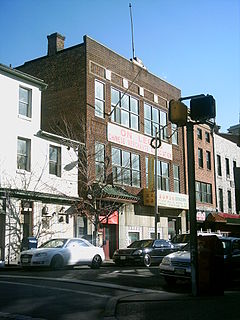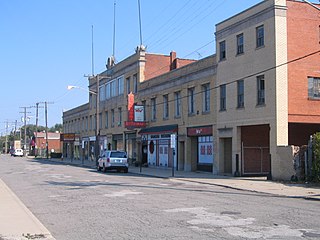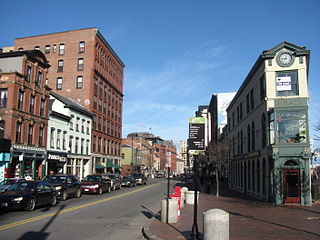
A Chinatown is an ethnic enclave of Chinese people located outside mainland China, Hong Kong, Macau or Taiwan, most often in an urban setting. Areas known as "Chinatown" exist throughout the world, including Europe, North America, South America, Asia, Africa, Australia, Zealandia and the Middle East.

Chinatown is a neighborhood in Downtown Los Angeles, California that became a commercial center for Chinese and other Asian businesses in Central Los Angeles in 1938. The area includes restaurants, shops and art galleries but also has a residential neighborhood with a low-income, aging population of about 20,000 residents.

Chinatowns in Europe include several urban Chinatowns that exist in major European capital cities. There is a Chinatown in London, England, as well as major Chinatowns in Manchester, Birmingham, Newcastle and Liverpool. In Paris there are two Chinatowns: one where many Vietnamese – specifically ethnic Chinese refugees from Vietnam – have settled in the Quartier chinois in the 13th arrondissement of Paris, and the other in Belleville in the northeast of Paris. Berlin, Germany has two Chinatowns, one in the East and one in the West. Antwerp, Belgium also has an upstart Chinese community.

The Chinatown neighborhood in Oakland, California(Chinese: 屋崙華埠), is a pan-Asian neighborhood which reflects Oakland's diverse Asian American community. It is frequently referred to as "Oakland Chinatown" in order to distinguish it from nearby San Francisco's Chinatown. It lies at an elevation of 39 feet.

Chinatown in Montreal is located in the area of De la Gauchetière Street in Montreal. The neighbourhood contains many Asian restaurants, food markets, and convenience stores as well being home to many of Montreal's East Asian community centres, such as the Montreal Chinese Hospital and the Montreal Chinese Community and Cultural Center. CHUM Hospital is located in Chinatown.

Philadelphia Chinatown is a predominantly Asian American neighborhood in Center City, Philadelphia. The Philadelphia Chinatown Development Corporation supports the area. The neighborhood stretches from Vine Street on the north to Arch Street on the south, and from North Franklin Street and North 7th Street on the east to North Broad Street on the west. Unlike some other traditional Chinatowns, the Philadelphia Chinatown continues to grow in size and ethnic Chinese population, as Philadelphia itself is, as of 2018, experiencing significant Chinese immigration from New York City, 95 miles (153 km) to the north, and from China, the top country of birth by a significant margin sending immigrants to Philadelphia.

Chinatown, Boston is a neighborhood located in downtown Boston, Massachusetts. It is the only surviving historic ethnic Chinese enclave in New England since the demise of the Chinatowns in Providence, Rhode Island and Portland, Maine after the 1950s. Because of the high population of Asians and Asian Americans living in this area of Boston, there is an abundance of Chinese and Vietnamese restaurants located in Chinatown. It is one of the most densely populated residential areas in Boston and serves as the largest center of its East Asian and Southeast Asian cultural life. Chinatown borders the Boston Common, Downtown Crossing, the Washington Street Theatre District, Bay Village, the South End, and the Southeast Expressway/Massachusetts Turnpike. Boston's Chinatown is one of the largest Chinatowns outside of New York City.

Mott Street is a narrow but busy thoroughfare that runs in a north–south direction in the New York City borough of Manhattan. It is regarded as Chinatown's unofficial "Main Street". Mott Street runs from Bleecker Street in the north to Chatham Square in the south. It is a one-way street with southbound-running vehicular traffic only.

Louttit Laundry was at one time the largest laundry business in Rhode Island, with 150 employees and 16 outlets throughout the state. Their historic building at 93 Cranston Street was on the National Register of Historic Places. The company was sold in 1985 and closed in 1987. The Cranston Street building was built in 1906, expanded in 1925, damaged by fire in 2001, and demolished in 2008.

Chinatown and Little Italy is a business revitalization zone (BRZ) created by the City of Edmonton, roughly comprising the informal Chinatown and Little Italy ethnic enclaves in the city's inner neighbourhoods. The boundaries of the BRZ includes only the "commercial strips" within those enclaves, and the BRZ itself straddles the official neighbourhoods of McCauley and Boyle Street.

Chinatown in St. Louis, Missouri, was a Chinatown near Downtown St. Louis that existed from 1869 until its demolition for Busch Memorial Stadium in 1966. Also called Hop Alley, it was bounded by Seventh, Tenth, Walnut and Chestnut streets.
This article contains a list of the Chinatowns, which are either officially designated neighborhoods or historically important, in the United States. Historically speaking, many of these Chinatowns were formed in the 1800s Chinese diaspora and have served as ethnic Chinese enclaves.

William R. Walker & Son was an American architectural firm in Providence, Rhode Island, active during the years 1881 to 1938. It included partners William Russell Walker (1830–1905), William Howard Walker (1865–1922), and later, William Russell Walker II (1889–1936).

Historically, the city of Salt Lake City, Utah, had a Chinatown that was located in a section called "Plum Alley" that contained a Chinese population that worked in the mining camps and the transcontinental railroad. The first Chinese peoples came in the 1860s and had formed a historical Chinatown in a section called "Plum Alley" on Second South Street which lasted until 1952. The area had a network of laundromats, restaurants and oriental specialty shops.

The U.S. city of Baltimore, Maryland is home to a small Chinatown. Historically, Baltimore had at least two districts that were called "Chinatown" where the first one existed on the 200 block of Marion Street during the 1880s. A second and current location is at the 300 block of Park Ave., which was dominated by laundries and restaurants. The initial Chinese population came because of the transcontinental railroad, however, the Chinese population never exceeded 400 as of 1941. During segregation, Chinese children were classified as "white" and went to the white schools. Chinatown was largely gone by the First World War due to urban renewal. Although Chinatown was largely spared from the riots of the 1960s, most of the Chinese residents moved to the suburbs. As of 2009, the area still shows signs of blight and does not have a Chinese arch. As of 2017, the area has become an “immigration hub” for Ethiopian people.. In 2018, a mural of a Chinese dragon and an African lion was painted to signify the past as a Chinatown and the present as an African neighborhood. A night market in September 2018 marked the first Asian celebration of the area to an area that was “long forgotten and neglected”.

Asiatown, also spelled AsiaTown and formerly known as Chinatown, is a Chinatown located in Cleveland, Ohio, in the United States. Chinese people, brought to the country as railroad workers, established the area in the 1860s. The area became known as Chinatown in the 1920s, and was then centered at Rockwell Avenue and E. 22nd Street. Large numbers of non-Chinese people from Asia settled in the area in the 1960s and 1970s, leading to the enclave's expansion eastward. The expanded enclave was named Asiatown in 2006, with that portion on Rockwell Avenue often being referred to as "Old Chinatown" or "Historic Chinatown".

The city of New Orleans was once home to one of the largest Chinatowns in the Southern United States. It existed from the 1880s until its destruction by WPA re-development in 1937, and it was located at the end of Tulane Avenue, at the 1100-block near Elk Place and South Rampart Street, south of the Tulane stop on the modern North Rampart streetcar line.

Daniel Howard Thornton (1870–1911) was an American architect from Providence, Rhode Island.

Chinese-Americans in Portland, Maine refers to the Chinese-American residents and businesses of Portland, Maine, USA. An informal and small Chinatown once existed around Monument Square. The first Chinese person arrived in 1858 with the Chinatown forming around 1916, mainly lasting until around 1953. The last vestiges of Chinatown lingered until 1997 when the last Chinese laundry closed. By that time, urban renewal already claimed all of the remaining buildings.

First Chinatown is a retronym for a former neighbourhood in Toronto, an area that once served as the city's Chinatown. The city's original Chinatown existed from the 1890s to the 1970s, along York Street and Elizabeth Street between Queen and Dundas Streets within St. John's Ward. However, more than two thirds of it was expropriated and razed starting in the late 1950s to build the new Toronto City Hall and its civic square, Nathan Phillips Square.



















